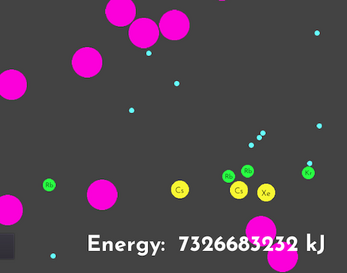Nuclear Fission Simulation
Click the checkboxes to disable/enable the displays.
Science: Nuclear fission is an incredibly efficient and relatively clean way to make a lot of energy. In nuclear power plants, a neutron is fired at Uranium-235, an extremely unstable isotope. When the neutron gets forcefully added to its nucleus, it becomes unstable enough to split apart. The result is two byproducts*, 3 neutrons, and energy (calculated with E=mc^2). The creation of three more neutrons causes a chain reaction of nuclear fission.
Model: This model simulates a nuclear fission reaction with one mole of uranium-235 (each particle representing 1/16 of a mole or 3.763 * 10^22 particles). When a neutron hits a Uranium-235 atom, the model creates 3 neutrons and two byproducts* in its place. It also adds 1221113872 kJ to the system. Particle collisions are extremely simplified in this model. Slide collisions don't take into account velocity or direction and are will just try to move past another particle.
Argument: Nuclear energy should be reexamined as an alternative energy source. It is superior to coal in every way. It is more efficient in energy production by (in this model) 325,000 times than the best coal. It produces far less waste for far more energy and unlike coal, the waste is contained in barrels and not pumped into the atmosphere. While nuclear technology may have a bad stigma, nuclear energy far outclasses any fossil fuel in safety. This does not have to be a permanent solution. We just need to switch off coal as soon as possible and let other clean energy source technology develop.
Model Limitations: (1) The nonexistent particle physics will result in buggy collisions. (2) There are simply too many nuclear fission reactions that can occur, so the model only uses three of them. (3) The model fails to acknowledge control rods which slow down neutron movement for a controlled energy output.
How does it compare? Very well. Unlike in coal combustion, only one reaction is made possible in this model environment. The results are consistently accurate because of this
* Chemical Reactions - these are just three of the many chemical reactions that can happen in nuclear fission. Each reaction creates 202.5 MeV of energy, resulting in an energy output of 19.54 Tj/mol.
- n + U-235→ Ba-141 + Kr-92 + 3n
- n + U-235 → Cs-143 + Rb-90 + 3n
- n + U-235 → Xe-143 + Kr-90 + 3n
Main Sources:
| Status | In development |
| Category | Other |
| Platforms | HTML5 |
| Author | spencerho777 |

Leave a comment
Log in with itch.io to leave a comment.